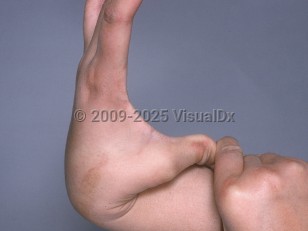Marfan syndrome in Child
Alerts and Notices
Important News & Links
Synopsis

Marfan syndrome is a connective tissue disorder that affects multiple organ systems. It is caused by a mutation in the fibrillin-1 (FBN1) gene, which encodes a protein that is a major component of extracellular matrix microfibrils. FBN1 is necessary for normal functioning of the structural framework of tissue. The mutation is typically heterozygous in nature and passed down in an autosomal dominant inheritance pattern. The majority of those affected have a family history of the disease. However, 25% of affected individuals appear to have acquired de novo mutations.
FBN1 is found throughout the body, explaining the numerous manifestations of the syndrome. The most commonly affected organ systems are the cardiovascular, skeletal, and ocular systems. These organ systems are particularly susceptible because they contain an abundant amount of FBN1. Common manifestations include hyperextensible joints, lens dislocation, skeletal abnormalities, and aortic aneurysms.
Cutaneous manifestations are less common, but striae distensae occur in two-thirds of patients. Inguinal or incisional hernias are also more commonly seen in affected individuals. Elastosis perforans serpiginosa is a rare cutaneous feature.
Marfan syndrome has an approximate incidence of 2-3 in 10 000 individuals worldwide without predilection for age, sex, or ethnicity. Clinical features become more apparent with increasing age.
Pediatric Patient Considerations:
This condition is difficult to diagnose in children as many features are age dependent.
Related topic: Cystic medial necrosis
FBN1 is found throughout the body, explaining the numerous manifestations of the syndrome. The most commonly affected organ systems are the cardiovascular, skeletal, and ocular systems. These organ systems are particularly susceptible because they contain an abundant amount of FBN1. Common manifestations include hyperextensible joints, lens dislocation, skeletal abnormalities, and aortic aneurysms.
Cutaneous manifestations are less common, but striae distensae occur in two-thirds of patients. Inguinal or incisional hernias are also more commonly seen in affected individuals. Elastosis perforans serpiginosa is a rare cutaneous feature.
Marfan syndrome has an approximate incidence of 2-3 in 10 000 individuals worldwide without predilection for age, sex, or ethnicity. Clinical features become more apparent with increasing age.
Pediatric Patient Considerations:
This condition is difficult to diagnose in children as many features are age dependent.
Related topic: Cystic medial necrosis
Codes
ICD10CM:
Q87.40 – Marfan's syndrome, unspecified
SNOMEDCT:
19346006 – Marfan syndrome
Q87.40 – Marfan's syndrome, unspecified
SNOMEDCT:
19346006 – Marfan syndrome
Look For
Subscription Required
Diagnostic Pearls
Subscription Required
Differential Diagnosis & Pitfalls

To perform a comparison, select diagnoses from the classic differential
Subscription Required
Best Tests
Subscription Required
Management Pearls
Subscription Required
Therapy
Subscription Required
References
Subscription Required
Last Reviewed:12/19/2021
Last Updated:01/10/2022
Last Updated:01/10/2022
Marfan syndrome in Child

